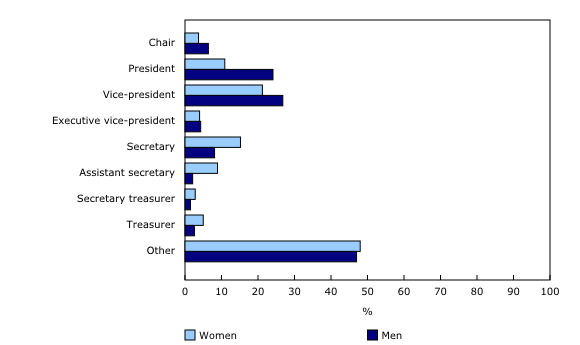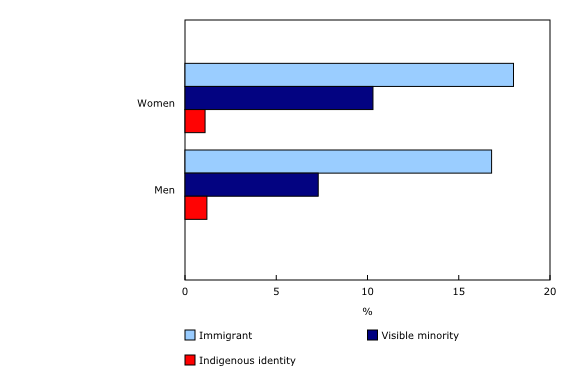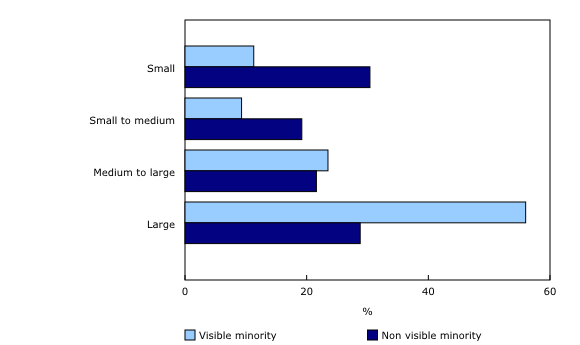Study: Diversity among board directors and officers: Exploratory estimates on family, work and income
Archived Content
Information identified as archived is provided for reference, research or recordkeeping purposes. It is not subject to the Government of Canada Web Standards and has not been altered or updated since it was archived. Please "contact us" to request a format other than those available.
Released: 2021-05-18
Despite decades of gains in the workplace, women and equity-deserving groups continue to be underrepresented in leadership and decision-making positions.
A new Statistics Canada study provides the first socioeconomic profile of women executives (board directors and officers) from an intersectional lens in Canada, providing exploratory estimates on disparities by gender and visible minority status for family, work and income characteristics. The study also analyzes the types of businesses where diverse women executives contribute to corporate governance and strategic decision-making.
Additional information related to gender and corporations can be found on the Gender, Diversity and Inclusion Statistics Hub and on the Business performance and ownership statistics portal.
Fewer women in top decision-making roles
Women who reach executive roles in their careers tend to hold lower-level positions than men, or ones with less decision-making authority—patterns that are reflected in the exploratory estimates. Specifically, almost 1 in 2 women executives contributed to corporate governance and strategic decision-making in one company or in multiple companies as both board directors and officers, relative to 6 in 10 men. Furthermore, women officers were more than two times less likely than men officers to be in top roles, such as chairman or president. In fact, 1 in 10 women officers were presidents, compared with almost 1 in 4 men officers.
Visible minority women are outnumbered in executive positions, while very few Indigenous women are identified in the estimates
About 1 in 10 women executives belonged to a visible minority group in the exploratory estimates, relative to about 1 in 5 women in the overall working population, reflecting their underrepresentation in leadership positions. Major visible minority groups for executives included South Asian and Chinese, while there was little representation for Black and Filipino executives.
Very few Indigenous women were identified in the exploratory estimates, reaching about 1%, a lower share when compared with their representation in the working population (4%). Immigrant women were relatively better represented in executive positions, accounting for about 18% of executive women, compared with almost one in four workers. In contrast with patterns for the broader immigrant population, the majority of immigrant women who reached executive positions did not identify as visible minorities.
Visible minority women executives are younger, more educated and more likely to have children than non-visible minority women
While women executives were younger than men and less likely to have children, visible minority women executives were younger than non-visible minority women and more likely to have children. They also had a higher level of educational attainment than non-visible minority women. For example, about 9 in 10 visible minority women had a bachelor's degree or above, relative to about 3 in 4 non-visible minority women. Examining occupational differences, visible minority women were less likely than women executives who did not identify as visible minorities to work as managers, while more likely to work in social sciences, education, government service and religion, primarily as lawyers or Quebec notaries, and almost twice as likely to work as financial auditors and accountants.
Visible minority women five times more likely than non-visible minority women to participate on American-controlled corporations
Major differences were observed in the types of corporations where visible minority women executives contributed or the extent of their corporate roles. Notably, about 6 in 10 executive women who belonged to a visible minority group contributed in officer roles exclusively, while about 1 in 3 participated as both officers and board directors, compared with almost half of non-visible minority women executives.
Overall, visible minority women executives were just as likely to access top officer roles as non-visible minority women. Notably, visible minority women executives were five times more likely to participate in American-controlled corporations, and while in these corporations, 1.4 times more likely than non-visible minority women executives to hold a board seat and an officer position simultaneously.
With regard to firm characteristics, women executives who belonged to a visible minority group were 1.9 times more likely than non-visible minority women executives to participate in the largest firms—mainly reflecting trends for officers—while much less likely to contribute in the smallest firms and more likely to work in the finance sector.
Women executives earn about 56% less than men executives
Women executives made about 56% less than men executives, as their average total income reached $495,600, relative to about $1.1 million for men. By major occupational group, wider gaps were observed for management occupations and narrower gaps for health and social science occupations, where women were relatively better represented. Visible minority women executives made about 32% less than non-visible minority women, at an average of $347,100.
Even when controlling for major employment characteristics that typically explain income disparities for the broader working population, the gender pay gap and minority gap for executives remained considerable. Participating on more boards was associated with higher income for executives, though to a considerably greater extent for men.
Note to readers
Estimates presented in "Diversity for board directors and executive officers: Exploratory estimates on family, work and income" were created by identifying board directors and executive officers in 2016 and 2017 through the Corporations Returns Act, which were linked to the Derived Record Depository and then the 2016 Census. For more information, see the article.
Company size was determined by assets, then classified by quartiles. More specifically, smaller firms were classified in the first quartile, small-to-medium companies were classified in the second quartile, medium-to-large firms were classified in the third quartile and larger firms were classified in the fourth quartile.
Products
The study, "Diversity Among Board Directors and Officers: Exploratory Estimates on Family, Work and Income," part of the Analytical Studies Branch Research Paper Series (11F0019M), is now available.
Also released today is an infographic titled, "Diversity among board directors and officers," available as part of the series Statistics Canada – Infographics (11-627-M).
Contact information
For more information, or to enquire about the concepts, methods or data quality of this release, contact us (toll-free 1-800-263-1136; 514-283-8300; STATCAN.infostats-infostats.STATCAN@canada.ca) or Media Relations (613-951-4636; STATCAN.mediahotline-ligneinfomedias.STATCAN@canada.ca).
- Date modified:




